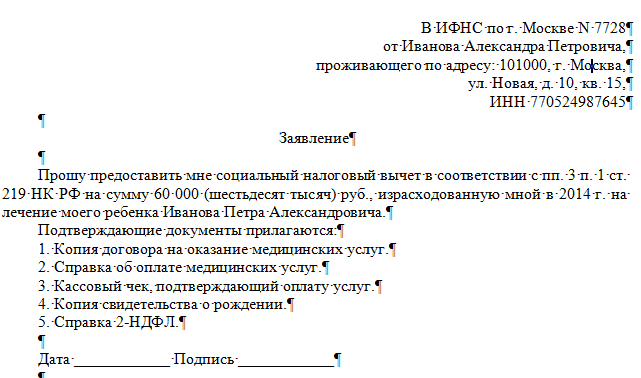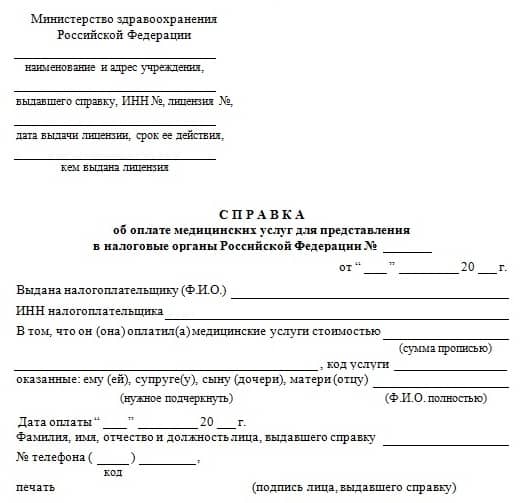How to get 13 percent back for treatment in a paid clinic
Tax rebates for treatment or the purchase of medicines are classified as social deductions and are provided only if the individual has prepared and correctly completed all the necessary documentation. In this article, we will talk about what documents are needed to get 13 percent back from medical services.
The tax legislation of the Russian Federation, namely Article 219 (clause three), provides for a reduction in the size of the taxable base for individuals who have paid for medical services or spent on the purchase of expensive drugs.
Thus, if the taxpayer was forced to invest material resources in treatment, then he has the right to return back some of them.
What needs to be done in order to return personal income tax for treatment
Please note that not everyone can take advantage of the social tax deduction. The tax office will charge compensation only if the following conditions are met:
- Personal income tax payment. Tangible assets that are returned as compensation are deducted from the amount given by an individual for income tax to the state treasury. In this regard, in order to receive a deduction, it is necessary to give 13% of all income for personal income tax. Individuals who are not taxpayers are not eligible for a tax credit;
- Correct paperwork. Since you can return the travel tax associated with medical expenses not only for yourself, but also for the child, father, mother, brother or sister, all documents confirming the fact of payment must be drawn up in the name of the same individual ;
- License. Today, more and more taxpayers prefer to use the services of a paid clinic. When undergoing treatment in the clinic, it is also possible to receive a tax deduction, but it is necessary that this institution has a license, as well as all other documents confirming the legality of its activities.
When to Apply for Medical Tax Deduction
It often happens that the package of documents is fully assembled and executed properly, and the taxpayer still does not receive such a long-awaited monetary compensation. As a rule, this is due to non-compliance with the deadlines for filing business papers.
Documents must be sent to the tax office only in the year that follows the year of payment for medical services.
For example, if a patient paid money for his treatment in a paid clinic in 2017, then you can use the service of calculating a deduction only in 2018, and information in all documents must be entered for 2017.
It should be noted that you can only receive a tax credit related to payment of treatment for the last three years. Therefore, if a person was treated in 2014, then the last opportunity to receive a deduction he has in 2017, and in 2018 this right automatically expires.
What documents are needed to return 13 percent for treatment
In order for the tax service to make a positive decision regarding the accrual of monetary compensation for payment for medical services, and also spend a minimum amount of time on a desk audit, we strongly recommend that you carefully consider the preparation of documentation. All information included in the documents must correspond to reality and not contain any corrections.
List of documents for refund of 13 percent for treatment
First of all, a taxpayer claiming a deduction needs to prepare documents that are mandatory for calculating any of the types of social deductions. This group includes the following business securities:
- Declaration. Without this document, the taxpayer will not be able to prove that the tax service has no claims against him. The declaration serves as a kind of report that contains absolutely all information about the income of an individual, as well as all kinds of transactions associated with them;
- Reference. Since the payment of income tax on wages, as a rule, is dealt with by the employer, and not the taxpayer himself, a certain form of document was introduced - 2-NDFL, in which all information about the payment of tax payments is entered;
- Statement. In order for the tax inspector not to doubt that the desire to receive a tax rebate for treatment really comes from the taxpayer himself, and not from outsiders, it is necessary to draw up such a document as a statement.

IMPORTANT! The application must be drawn up with his own hand by the applicant for the reduction of the tax base and must contain all the details of the account, to which, as a result, funds for treatment will be transferred.
Documents required for the deduction for treatment
After an individual who has incurred material expenses related to improving health has prepared a declaration, a certificate and a statement, he can proceed to the next stage - the collection of papers directly related to the costs of treatment. The claimant for the deduction must have the following documents:

If a tax rebate is issued in connection with the purchase of expensive medicines, then the only documentary evidence in this case is receipts from the pharmacy. It is on the basis of the checks provided that the attending physician will be able to write out a certificate, which will subsequently become a decisive factor for the tax service, prompting the issuance of monetary compensation.
Declaration for refund 13 percent for treatment
A document such as a tax return is not filled out in an arbitrary order, but in the form of 3-NDFL and requires compliance with many nuances. The declaration form consists of many pages, of which only a few are required.
In order to draw up the document correctly and figure out how to do this as soon as possible, we advise you to seek help from an inspector working in the tax service at the place of registration of the claimant for the deduction.
However, before starting to fill out the declaration form, the taxpayer must have the following documents, the information from which is entered into the document according to the 3-NDFL model:
- Taxpayer identification number and passport;
- Certificate of income, taken from the place of work, in the form of 2-NDFL;
- A certificate issued by a medical institution, which confirms the payment of a payment for treatment;
- Checks, receipts, as well as any other payment documents.
